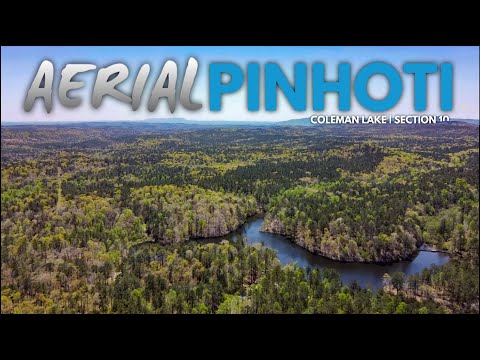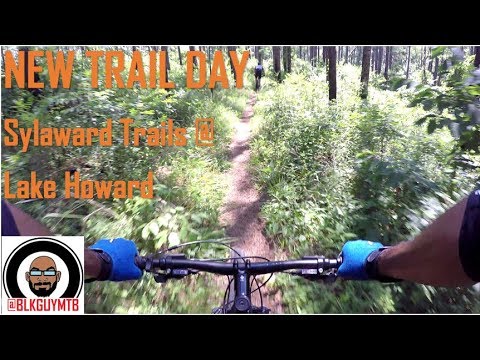The Talladega National Forest is a beautiful national forest spanning close to 400,000 acres (625 sq mi) of wilderness areas in the eastern part of Alabama. Located on the southern edge of the Appalachian Mountains and managed by the U.S. Forest Service, this park is home to a wide variety of wildlife, including endangered species. It is also one of the best spots in the Southeastern United States for outdoor sports.
Below, we’ve written your complete guide to Talladega. We’ll talk about its history, go over the major areas and districts, and talk about things to see and do in the forest.
About Talladega National Forest
The Talladega National Forest covers over 392,000 acres and features a variety of ecosystems, including mountains, forests, and rivers. Wildlife you can find here include white-tailed deer, bobcats, black bears, turkey, rabbit, and raccoons. Plants found here include the longleaf pine, loblolly pines, and numerous species of hardwoods, like oak, hickory, and poplar.

Alabama Gentians in Talladega National Forest. Chris Hartman via Wikimedia.
History of the forest
The area now known as Talladega was once home to the Creek and Cherokee Native American Tribes before European settlers arrived. The Creek Tribe settled mostly the southern portion of the forest, while the Cherokee tribe settled mostly the northern portion. The Chalaka tribe, originally from Ohio, also settled in this area.
Europeans came in 1540, originally searching for gold. Fort Toulouse, the easternmost outpost of the French territory of Louisiana, was built here in 1717. The French used the fort until 1763, when they abandoned it after losing to the British in the French and Indian War.
Numerous other events took place here, including the Creek War, which eventually led to the Creek Tribe being forced to give up millions of acres of land under the Treaty of Fort Jackson. The Indian Removal Act, passed in 1830, forced the Creeks to give up their land and move west, mostly to present-day Oklahoma.
The land was bought by the federal government in the 1930s. The National Forest Commission established the Oakmulgee Purchase Unit in what is now the Oakmulgee District of the Talladega National Forest. Talladega was then established as a national forest in 1936 by President Franklin Roosevelt through a presidential proclamation.
Major Districts
Talladega National Forest is divided into several major districts:
- Oakmulgee Ranger District: Oakmulgee covers over 157,000 acres of the forest and straddles the Cahaba River. It is home to the largest contiguous longleaf forest in Alabama. The popular Payne Lake Recreation Area is located in the western part of Okamulgee.
- Shoal Creek Ranger District: Shoal Creek, located in the central and northern parts of the forest, contains numerous recreation areas.
These include:
- Coleman Lake Recreation Area
- Pine Glen Recreation Area
- Warden Station Horse Camp
- Hunter Camps: Pendergrass, Skeeter Branch & East End Hunter Camps
- Big Oak Hunter Camp
- Talladega Ranger District: The Talladega District is in the southernmost portion of the park. It has plenty of hiking, mountain biking, ATV riding, and other outdoor activities.
In addition to these districts, the forest is also home to the Dugger Mountain Wilderness and Cheaha Wilderness areas.
Finally, the park is on the Cheaha State Park’s boundaries. It is also on the boundary of the Mountain Longleaf National Wildlife Refuge. Both make for excellent side trips while you’re in the area.
Outdoor Activities
There are few places in the southeast better than Talladega’s pristine wilderness for experiencing the outdoors. Below, we’ll look at the outdoor activities you can enjoy in the forest.
Hiking
The Pinhoti Trail System spans over 100 miles of hiking within the forest system. You can also take side trails into the Cheaha Wilderness and Cheaha State Park areas. From there, you can hike up Cheaha Mountain, the natural highest point in Alabama, via the Lake Trail.
Side trails in this system include:
- Odum Scout Trail (4 miles)
- Chinnabee Silent Trail (5.3 miles)
- Nubbin Creek (4 miles)
- Cave Creek (3.3 miles)
- Skyway (6 miles)
- Lake Shore (2 miles)
There are plenty of places that provide easy access to the Pinhoti System. The Porter’s Gap Trailhead is an especially popular place to get started.
There are even more hiking opportunities within Cheaha State Park, which is directly connected to Talladega. Check out a full list of trails in the State Park here.
Camping
Camping in the Talladega National Forest is a popular activity. There are several campgrounds located within the forest that offer a variety of amenities, such as picnic tables, fire pits, and restrooms. Some of the campgrounds are equipped with RV hookups, while others are more rustic and do not have any electricity or running water.
In addition to the developed campgrounds, the Talladega National Forest also has several designated backcountry camping areas. These areas are located deep within the forest and are accessible only by hiking or horseback riding. Backcountry camping is a more primitive experience, and campers must be self-sufficient and prepared to provide their own water and supplies.
To camp in the Talladega National Forest, you’ll need to get a permit from the forest service. Permits can be obtained at any of the forest service offices located within the forest, or online through the forest service website. In addition to the permit, campers are also required to pay a camping fee.
Here are some of the major areas for camping:
- Turnipseed Camp: A primitive campground located in the Cheaha Wilderness.
- Hunter Camps: There are a total of 7 sites at the Hunter Camps. All are primitive sites with no sanitary facilities
- Coleman Lake Recreation Area: 39 sites that include water and electric hookups, bath houses, and picnic shelters.
- Pine Glen Recreation Area: 21 campsites that offer sanitary facilities, grills, and close access to the Pinhoti Trails.
- Warden Station Horse Camp: 45 campsites for tent and small RV camping. All sites are primitive camping.
- Big Oak Hunter Camp: A 1700-acre area specifically for hunters with physical disabilities.
Hunting
Hunting is allowed in Talladega National Forest, but there are certain restrictions and regulations that must be followed. Before hunting in the national forest, make sure to check with the Alabama Department of Conservation and Natural Resources for information on seasons, bag limits, and other regulations. You will also need to obtain a valid hunting license and any necessary permits. Check out more on hunting in Alabama on the USDA website.
Big game hunting is allowed in all three ranger districts. That includes 10 sites in Oakmulgee, 7 sites in Talladega, 4 sites in Shoal Creek, and the Big Oak Physically Disabled site, also located in Shoal Creek.
Target Shooting
The South Sandy Shooting Range, managed in partnership with the Alabama Wildlife and Freshwater Fisheries, is a great place for recreational target shooting. Download the range’s brochure here.
You can also target shoot at the Vick Shooting Range, in the Oakmulgee District, as well as at the Shepherd Branch Shooting Range, in the Talladega District.
Lastly, the Henry Creek Shooting Range, located in Shoal Creek, offers target shooting for rifles at 50 and 100 yards.
Fishing
Fishing is also allowed in Talladega at multiple sites. Here are our favorites.
Payne Lake Recreation Area
Payne Lake is is approximately 110 acres in size and was created in the 1930s by the Civilian Conservation Corps as a part of their efforts to develop the Talladega National Forest. The lake is fed by Cheaha Creek, which flows through the surrounding forest and provides a habitat for a variety of fish species, including bass, bream, and catfish.
There are 26 campsites there, each of which has a picnic table, fire circle, and tent or trailer pad.
Coleman Lake
Camping is also a popular activity at Coleman Lake, with several campgrounds located near the lake. Coleman Lake features a total of 39 campsites with water and electrical hookups, bath houses, and more.
There is also a picnic shelter that can seat up to 40 people that can be reserved for $15.
High Rock Lake
High Rock is much smaller than many of the other lakes in the forest, at 19 acres. It is located about 1 mile south of the Pine Glen Recreation Area, which features 21 campsites, grills, sanitary facilities, and more.
Morgan Lake
Morgan Lake is another favorite. While only 14 acres in size, it offers prime fishing for bass, bream, and catfish. Parking is available for up to 15 vehicles with trailers.
Sweetwater Lake
This 58 acre lake sits between Coleman Lake and the Pine Glen Recreation area. It has parking for up to 8 vehicles and trailers.
Horseback Riding
The primary place for horseback riding in Talladega is the Warden Station Horse Camp. It offers 30 miles of trails for you and your horse. There are 45 primitive campsites, which can accommodate both tents and RVs. There are also 4 loop trails for hiking and picnicking.
Mountain Biking
The Sylaward mountain bike trails have the best mountain biking in the park. It runs a total of 14 miles and snakes through Talladega, starting at Lake Howard. You can also hike on this trail, so if you’ve got family that doesn’t mountain bike they can still come out and enjoy it with you.
You can also mountain bike on the Kentcuk OHV Trailhead system. It has a total of 23 miles of trails, but will be shared with ATVs.
Lastly, the Cheaha State Park has 5 different mountain biking trails you can enjoy while you’re in the area.
ATV Riding
The Kentuck OHV Trailhead (also called the Kentuck ORV Trailhead) is the primary place for ATV riding. You can also mountain bike here or bring your motorcycle. There are a total of 4 trails totaling a distance of 23 miles. The difficulty ranges from easy, with smooth riding and not much change in grade, to rocky and bumpy, so both beginners and expert riders can enjoy this area.
Scenic Driving
Lots of people love the Talladega Scenic Drive opportunities. The Shoal Creek and Talladega Divisions have some scenic drives. There is also some great scenic driving within the Cheaha State Park.
Talladega attracts many visitors every year to enjoy the amazing 29-mile Talladega Scenic Byway.
Boating and Swimming
Swimming is allowed and Payne Lake and Coleman Lake. Another popular spot to swim is the Devil’s Den Waterfalls, which is access only via the Chinnabee Silent Trail.
Non-motorized boating is allowed at the following locations:
- Oakmulgee Ranger District
- Payne Lake Recreation Area
- Shoal Creek Ranger District
- Coleman Lake Recreation Area
- High Rock Lake
- Morgan Lake
- Sweetwater Lake
- Talladega Ranger District
- Lake Chinnabee Recreation Area
- Lake Virginia
- Little Lake Wills
Motorized boating is also allowed at some locations, but be sure to check before bringing your power boat to the park.
Birding
Talladega is a top spot for birders. The Pearson Gap Birding Loop Trail is a great spot to get started. This interactive trail covers over 9 miles and has QR codes for you to get more information on the interpretive trail.
Porter’s Gap is another great spot for birders. One of numerous trailheads in the Pinhoti Trail system, this spot provides higher elevations and the opportunity to see plenty of songbirds. Species found here include Scarlet Tangers, Cedar Waxwings, Ovenbirds, and Black-Throated Green Warblers.
Another favorite spot is Bull’s Gap, a top spot for Brown-Headed Nuthatches. Last but not least, don’t forget to check out Cheaha State Park for even more birding opportunities.
Wildlife Viewing
Wildlife other than birds you can find at the park include black bears, white-tailed deer, coyotes, rabbits, quails, foxes, and raccoons. The U.S. Forest Service recommends Coleman Lake as an especially good area for checking out the wildlife.
Rock Climbing
While there isn’t any advertised rock climbing opportunities within Talladega National Forest, Cheaha State Park does have rock climbing. You can enjoy the rock bluffs here on the Rock Gardens and Pulpit Rock trails. Be sure to check in with the office first to fill out paperwork and get more information on the climbing.
Geocaching
Geocaching is an outdoor game growing in popularity that is a hide-and-seek game using GPS. You can play the game in the Talladega National Forest as well as at Cheaha State Park. For geocaches, be sure to check out www.geocaching.com.
Maps of the Park
Before you go, be sure to print a map. While you can download it to your phone through the USDA app, it’s probably best to have a printed copy before heading into a wilderness area. Below are maps of all the major areas.







